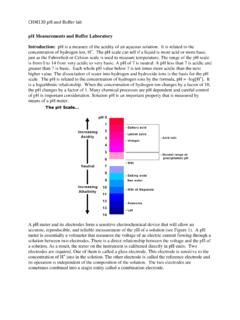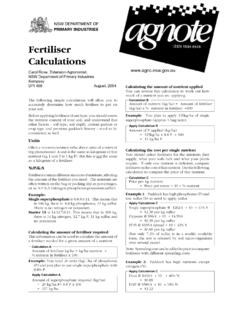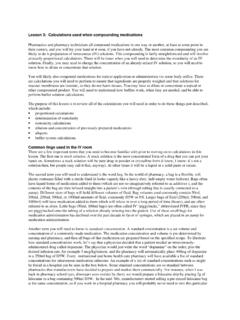Transcription of Computer Graphics - Tutorials Point
1 R Computer Graphics About the Tutorial To display a picture of any size on a Computer screen is a difficult process. Computer Graphics are used to simplify this process. Various algorithms and techniques are used to generate Graphics in computers. This tutorial will help you understand how all these are processed by the Computer to give a rich visual experience to the user. Audience This tutorial has been prepared for students who don't know how Graphics are used in computers. It explains the basics of Graphics and how they are implemented in computers to generate various visuals.
2 Prerequisites Before you start proceeding with this tutorial, we assume that you are already aware of the basic concepts of C programming language and basic mathematics. Copyright & Disclaimer Copyright 2016 by Tutorials Point (I) Pvt. Ltd. All the content and Graphics published in this e-book are the property of Tutorials Point (I). Pvt. Ltd. The user of this e-book is prohibited to reuse, retain, copy, distribute or republish any contents or a part of contents of this e-book in any manner without written consent of the publisher. We strive to update the contents of our website and Tutorials as timely and as precisely as possible, however, the contents may contain inaccuracies or errors.
3 Tutorials Point (I) Pvt. Ltd. provides no guarantee regarding the accuracy, timeliness or completeness of our website or its contents including this tutorial. If you discover any errors on our website or in this tutorial, please notify us at i Computer Graphics Table of Contents About the Tutorial .. i Audience .. i Prerequisites .. i Copyright & i Table of Contents .. ii 1. Computer Graphics BASICS .. 1. Cathode Ray Tube .. 1. Raster Scan .. 2. Application of Computer Graphics .. 3. 2. Computer Graphics LINE GENERATION ALGORITHM .. 4. DDA Algorithm.
4 4. Bresenham's Line Generation .. 5. Mid- Point Algorithm .. 7. 3. Computer Graphics CIRCLE GENERATION ALGORITHM .. 9. Bresenham's Algorithm .. 9. Mid Point Algorithm .. 11. 4. Computer Graphics POLYGON FILLING .. 13. Scan Line Algorithm .. 13. Flood Fill Algorithm .. 14. Boundary Fill Algorithm .. 14. 4-Connected Polygon .. 15. 8-Connected Polygon .. 16. Inside-outside Test .. 17. ii Computer Graphics 5. Computer Graphics VIEWING AND CLIPPING .. 20. Point Clipping .. 20. Line Clipping .. 20. Cohen-Sutherland Line Clippings .. 20. Cyrus-Beck Line Clipping Algorithm.
5 23. Polygon Clipping (Sutherland Hodgman Algorithm) .. 24. Text Clipping .. 25. Bitmap Graphics .. 27. 6. Computer Graphics 2D TRANSFORMATION .. 29. Homogenous Coordinates .. 29. Translation .. 29. Rotation .. 30. Scaling .. 32. Reflection .. 33. Shear .. 34. Composite 35. 7. Computer Graphics 3D Graphics .. 37. Parallel Projection .. 37. Orthographic Projection .. 38. Oblique Projection .. 39. Isometric Projections .. 39. Perspective Projection .. 40. Translation .. 41. Rotation .. 42. Scaling .. 43. iii Computer Graphics Shear .. 44. Transformation 45.
6 8. Computer Graphics CURVES .. 46. Types of Curves .. 46. Bezier 46. Properties of Bezier Curves .. 47. B-Spline Curves .. 48. Properties of B-spline Curve .. 49. 9. Computer Graphics SURFACES .. 50. Polygon Surfaces .. 50. Polygon Tables .. 50. Plane Equations .. 51. Polygon Meshes .. 52. 10. Computer Graphics VISIBLE SURFACE DETECTION .. 54. Depth Buffer (Z-Buffer) Method .. 54. Scan-Line Method .. 55. Area-Subdivision Method .. 56. Back-Face Detection .. 57. A-Buffer Method .. 58. Depth Sorting Method .. 60. Binary Space Partition (BSP) Trees.
7 61. 11. Computer Graphics FRACTALS .. 62. What are Fractals? .. 62. Generation of Fractals .. 62. Geometric Fractals .. 63. iv Computer Graphics 12. Computer Graphics Computer ANIMATION .. 65. Animation Techniques .. 65. Key Framing .. 66. Morphing .. 67. v 1. Computer Graphics Basics Computer Graphics Computer Graphics is an art of drawing pictures on Computer screens with the help of programming. It involves computations, creation, and manipulation of data. In other words, we can say that Computer Graphics is a rendering tool for the generation and manipulation of images.
8 Cathode Ray Tube The primary output device in a graphical system is the video monitor. The main element of a video monitor is the Cathode Ray Tube (CRT), shown in the following illustration. The operation of CRT is very simple: 1. The electron gun emits a beam of electrons (cathode rays). 2. The electron beam passes through focusing and deflection systems that direct it towards specified positions on the phosphor-coated screen. 3. When the beam hits the screen, the phosphor emits a small spot of light at each position contacted by the electron beam.
9 4. It redraws the picture by directing the electron beam back over the same screen points quickly. Figure: Cathode Ray Tube 6. Computer Graphics There are two ways (Random scan and Raster scan) by which we can display an object on the screen. Raster Scan In a raster scan system, the electron beam is swept across the screen, one row at a time from top to bottom. As the electron beam moves across each row, the beam intensity is turned on and off to create a pattern of illuminated spots. Picture definition is stored in memory area called the Refresh Buffer or Frame Buffer.
10 This memory area holds the set of intensity values for all the screen points . Stored intensity values are then retrieved from the refresh buffer and painted on the screen one row (scan line) at a time as shown in the following illustration. Each screen Point is referred to as a pixel (picture element) or pel. At the end of each scan line, the electron beam returns to the left side of the screen to begin displaying the next scan line. Figure: Raster Scan Random Scan (Vector Scan). In this technique, the electron beam is directed only to the part of the screen where the picture is to be drawn rather than scanning from left to right and top to bottom as in raster scan.


















